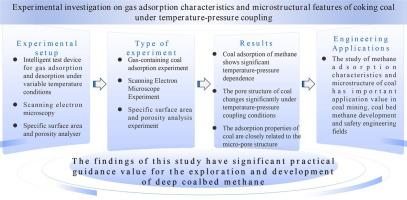Experimental investigation on gas adsorption characteristics and microstructural features of coking coal under temperature–pressure coupling
IF 7.5
1区 工程技术
Q2 ENERGY & FUELS
引用次数: 0
Abstract
Gas adsorption characteristics are significantly affected by coal pore structure and temperature and pressure conditions. In this paper, we investigated the adsorption characteristics and microstructural changes of coal samples through gas adsorption experiments, combined with scanning electron microscopy (SEM) and low-temperature liquid nitrogen adsorption experiments. The results show that the adsorption capacity increases with pressure and decreases with temperature; moreover, it under high and low pressures and high temperatures exhibits complex non-linear characteristics. For example, at 25 ℃, the adsorption capacity increases significantly with pressure; at 120 ℃, it is extremely low in the low-pressure zone but increases significantly in the high-pressure zone. This reflects that changes in pore structure enhance the adsorption capacity under high temperature and high pressure. Scanning electron microscopy (SEM) and low-temperature liquid nitrogen adsorption experiments show that an increase in temperature causes micropore collapse and consolidation, as well as a decrease in specific surface area; furthermore, pretreatment at 80 ℃/2.5 MPa could optimise the pore structure. This paper has also established application models applicable to three aspects: goaf gas control, goaf spontaneous combustion prevention and control, and goaf stability evaluation. These models provide theoretical support for the exploration and development of deep coalbed methane, as well as the condition optimization and technical improvement in the process of coalbed methane extraction.

温度-压力耦合作用下焦煤气体吸附特性及微观结构特征的实验研究
煤的孔隙结构和温度、压力条件对气体吸附特性有显著影响。本文通过气体吸附实验,结合扫描电镜(SEM)和低温液氮吸附实验,研究了煤样的吸附特性和微观结构变化。结果表明:吸附量随压力增大而增大,随温度升高而减小;此外,在高压、低压和高温下,它表现出复杂的非线性特性。例如,在25℃时,吸附量随压力的增大而显著增大;在120℃时,低压区极低,而在高压区显著增加。这反映了孔隙结构的变化增强了高温高压下的吸附能力。扫描电镜(SEM)和低温液氮吸附实验表明,温度升高导致微孔塌陷固结,比表面积减小;80℃/2.5 MPa预处理可以优化孔隙结构。建立了采空区瓦斯控制、采空区自燃防治和采空区稳定性评价三个方面的应用模型。这些模型为深部煤层气勘探开发以及煤层气开采过程中的条件优化和技术改进提供了理论支持。
本文章由计算机程序翻译,如有差异,请以英文原文为准。
求助全文
约1分钟内获得全文
求助全文
来源期刊

Fuel
工程技术-工程:化工
CiteScore
12.80
自引率
20.30%
发文量
3506
审稿时长
64 days
期刊介绍:
The exploration of energy sources remains a critical matter of study. For the past nine decades, fuel has consistently held the forefront in primary research efforts within the field of energy science. This area of investigation encompasses a wide range of subjects, with a particular emphasis on emerging concerns like environmental factors and pollution.
 求助内容:
求助内容: 应助结果提醒方式:
应助结果提醒方式:


